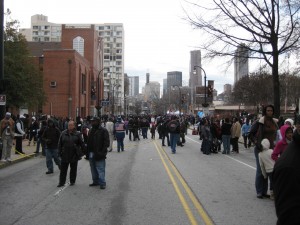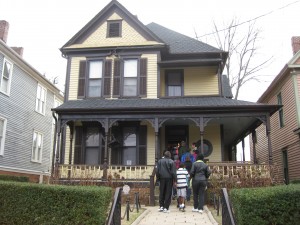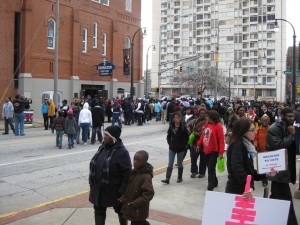 In the late 1970s and early 1980s, a blossoming movement rose forth to recognize the birthday of Martin Luther King, Jr. as a federally observed holiday, culminating with more than six million people signing a petition to Congress. In 1986, Martin Luther King, Jr. Day was first celebrated, three years after President Ronald Reagan signed a bill authorizing the third Monday in January as a federal holiday.
In the late 1970s and early 1980s, a blossoming movement rose forth to recognize the birthday of Martin Luther King, Jr. as a federally observed holiday, culminating with more than six million people signing a petition to Congress. In 1986, Martin Luther King, Jr. Day was first celebrated, three years after President Ronald Reagan signed a bill authorizing the third Monday in January as a federal holiday.
According to 2007 statistics, however, only a third of the nation’s employers give their employees the day off for the federal holiday, and it wasn’t until 2000 that every state in the union recognized the date as an official state holiday. Nor is the official terminology consistent throughout the country, with Arizona and New Hampshire celebrating the date as “Martin Luther King. Jr. Civil Rights Day” and Mississippi recognizing the day as a co-celebration of the lives of both King and Confederate General Robert E. Lee.
In the 1980s, former North Carolina Senator Jesse Helms led a vocal offensive against the push to recognize King’s birthday as a federal day of observance, accusing King of being a proponent of “action-oriented Marxism.” In 1990, Arizona voters were given the option to recognize Martin Luther King, Jr. Day as a state holiday, with more than three-quarters of the public voting against its observance.
The road to the recognition of Martin Luther King, Jr. Day as a federal holiday has been one filled with both promise and setbacks, with confrontation, ambivalence and in some cases, palpable disinterest. In some parts of the United States, the day is marked as a celebration of the human spirit and the progression of civil rights, and in others, the day is received tepidly, or perhaps even outright ignored.
Nowhere is this national dichotomy displayed more evidently than in Georgia, a state that seems incongruently divided not only on the holiday’s importance but the importance of King and the Civil Rights Movement of the 1950s and 1960s in general.
The mostly African-American Atlanta is a sharp contrast to the rest of his home state. In the predominantly white suburbs of metro-Atlanta, many communities boast of their Civil War histories, with Confederate emblems dotting cars, homes and businesses with almost the commonness of the United States flag. The capital city and its surrounding communities not only seem to be different environments, but can seem to be entirely different worlds.
 Although many vestiges of the racial disjunction King experienced and fought against can still be found, the Georgia that King grew up in no longer exists. While racial hostilities and disdain can still be felt and witnessed, the institutional prejudices of the Old South seem to have dissipated entirely, with population shifts slowly turning the formerly black and white metro area into a microcosm of the world at large. If Atlanta was characterized by racism at the time of King’s assassination, then in the modern day, it’s a city instead characterized by globalization.
Although many vestiges of the racial disjunction King experienced and fought against can still be found, the Georgia that King grew up in no longer exists. While racial hostilities and disdain can still be felt and witnessed, the institutional prejudices of the Old South seem to have dissipated entirely, with population shifts slowly turning the formerly black and white metro area into a microcosm of the world at large. If Atlanta was characterized by racism at the time of King’s assassination, then in the modern day, it’s a city instead characterized by globalization.
This Martin Luther King, Jr. Day in Atlanta was windy, but for January, unseasonably warm.
On Auburn Avenue, near where King grew up, the sundry funeral homes, record stores and barbershops were virtually blocked out by an array of street vendors, selling everything from Polish sausage to Philadelphia-style hot wings. A platoon of 99 Percenters marched down the potholed streets, chanting “No justice, no peace” while a congregation of young men and women clad in marching band regalia sang old hymns right next to Fire Station. No.6.
Women in birqas snapped pictures of the tombs of Martin Luther King, Jr. and his wife, Coretta, at the Freedom Hall memorial, which is stationed adjacent to Auburn Avenue. A young Hispanic child mulled tossing a penny into the reflecting pool, while his mother told him the story of the Civil Rights Movement.
Hundreds of people stood outside Ebenezer Baptist Church, waiting for their chance to snake through the queue and see the interior of the building where both King and his father once preached. Every year, a memorial service is held at the church; earlier in the day, Dr. Frederick Hayes, III, senior pastor at Friendship-West Baptist Church in Dallas, led the annual gathering, telling the congregation “If we’re going to make a difference in this world, we need somebody to get agitated”
[http://www.npr.org/2012/01/16/145308284/martin-luther-king-service-in-atlanta-gets-political]Down Auburn Avenue, another massive line awaited the opportunity to enter King’s boyhood home. It’s a modest two story house, with a glossy yellow and black paint scheme and almost waist high hedges connecting the lawn to the sidewalk. Compared to the series of tiny, pastel-hued “shotgun houses” across the street, the King Birth Home appeared almost manor-like.
At the Gandhi Promenade, a young boy asked his father who the bronzed man “with the walking stick” was. An older man, presumably his father, mussed his hair, and gave him a brief introduction to the life of “The Great Soul.”
 He started to read the inscription at the bottom of the statue, which is a quote from King. “If humanity is to progress, Gandhi is inescapable.” He didn’t bother reading the final sentence of the plaque, “we may ignore him at our own risk.”
He started to read the inscription at the bottom of the statue, which is a quote from King. “If humanity is to progress, Gandhi is inescapable.” He didn’t bother reading the final sentence of the plaque, “we may ignore him at our own risk.”
Blacks, Whites, Asians and Latinos all cautiously ambled down the International Civil Rights Hall of Fame. A Caucasian, college-aged girl with green hair stooped down to examine Stevie Wonder’s footprints. Several seconds later, an elderly African-American man with cottony white hair did the same, examining the walkway with the same sense of scrutiny -- and awe -- as the visitor most likely four or five decades his junior.
As the scores of people began exiting the Martin Luther King Jr. Center for Nonviolent Social Change, one had to wonder just how much the children that attended the day’s ceremonies really know about King, and the Civil Rights Movement that occurred perhaps as much as two decades before their parents were even born.
“Everybody should follow what he’s doing,” said Amanda, a 12-year-old attendee at the event, regarding the man being honored that evening. “Everybody should do what he’s doing.”
Uhmeara, a 5-year-old at the celebration, said that King was a man that simply wanted “good stuff” for his children.
“He wanted them to have fun, and he wanted them to share,” she said. “He wanted them to be friends, and be happy, and be free and have fun every time they play.”
In the distance, a gaggle of kids -- brown, black, and white -- gleefully ran about behind some nearby shrubbery, as the fading sun painted the Atlanta sky a glowing orange.
“He really had a dream,” Uhmeara continued. “And it really happened.”
To see more of our coverage of Atlanta's celebration of Martin Luther King, Jr. click here.
Photos by James Swift
